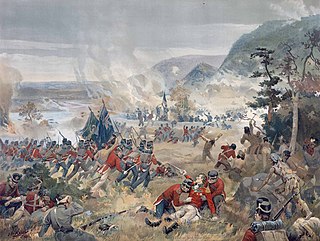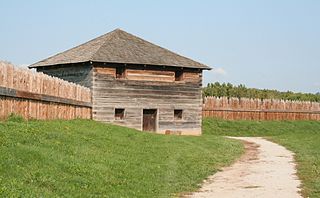
The Battle of Queenston Heights was the first major battle in the War of 1812. Resulting in a British victory, it took place on 13 October 1812 near Queenston, Upper Canada.
The Battle of York was a War of 1812 battle fought in York, Upper Canada on April 27, 1813. An American force, supported by a naval flotilla, landed on the western lakeshore and captured the provincial capital after defeating an outnumbered force of regulars, militia and Ojibwe natives under the command of Major General Roger Hale Sheaffe, the Lieutenant Governor of Upper Canada.

The Battle of Stoney Creek was a British victory over an American force fought on 6 June 1813, during the War of 1812 near what is now Stoney Creek, Ontario, Canada. British units made a night attack on the American encampment, and due in large part to the capture of the two senior officers of the American force and an overestimation of British strength by the Americans, the outcome of the battle was a total victory for the British, and a turning point in the defence of Upper Canada.

The Battle of Beaver Dams took place on 24 June 1813, during the War of 1812. A column of troops from the United States Army marched from Fort George and attempted to surprise a British outpost at Beaver Dams, billeting themselves overnight in the village of Queenston, Ontario. Laura Secord, a resident of Queenston, had earlier learned of the American plans from several Americans billeted at her house and had struck out on a long and difficult trek to warn the British at Decou's stone house near present-day Brock University. When the Americans resumed their march, they were ambushed by Kahnawake and other native warriors and eventually surrendered to a small British detachment led by Lieutenant James FitzGibbon. About 500 U.S. troops, including their wounded commander, were taken prisoner.

The siege of Fort Erie, also known as the Battle of Erie, from 4 August to 21 September 1814, was one of the last engagements of the War of 1812, between British and American forces. It took place during the Niagara campaign, and the Americans successfully defended Fort Erie against a British army. During the siege, the British suffered high casualties in a failed storming attempt; they also suffered casualties from sickness and exposure in their rough encampments. Unaware that the British were about to abandon the siege, the American garrison launched a sortie to destroy the British siege batteries, during which both sides again suffered high losses.

The Battle of Fort George was fought during the War of 1812, in which the Americans defeated a British force and captured Fort George in Upper Canada. The troops of the United States Army and vessels of the United States Navy cooperated in a very successful amphibious assault, although most of the opposing British force escaped encirclement.

The siege of Fort Meigs took place in late April to early May 1813 during the War of 1812 in northwestern Ohio, in present-day Perrysburg. A small British Army unit with support from Indians attempted to capture the recently constructed fort to forestall an American offensive against Detroit, and its Fort Detroit in the Great Lakes region which the British from the north in Canada had captured it the previous year. An American sortie and relief attempt failed with heavy casualties, but the British failed to capture the fort and were eventually forced to raise the siege.

The siege of Detroit, also known as the surrender of Detroit or the Battle of Fort Detroit, was an early engagement in the War of 1812. A British force under Major General Isaac Brock with indigenous allies under Shawnee leader Tecumseh used bluff and deception to intimidate U.S. Brigadier General William Hull into surrendering the fort and town of Detroit, Michigan, along with his dispirited army which actually outnumbered the victorious British and Indians.
The Battle of Longwoods took place during the Anglo-American War of 1812. On 4 March 1814, a mounted American raiding party defeated an attempt by British regulars, volunteers from the Canadian militia and Native Americans to intercept them near Wardsville, in present-day Southwest Middlesex, Ontario.

The Capture of Fort Niagara took place 18-19 December 1813 during the War of 1812 between Great Britain and the United States. The American garrison was taken by surprise, and the fort was captured in a night assault by a select force of British regular infantry.
Timeline of the War of 1812 is a chronology of the War of 1812, including a list of battles.

Colonel Caleb Hopkins was an officer during the War of 1812 and the first town supervisor of Pittsford, New York, United States.

The Battle of Buffalo took place during the War of 1812 on December 30, 1813, in the State of New York, near the Niagara River. The British forces drove off the American defenders and destroyed many buildings and ships. The operation was retaliation for American troops burning the Canadian village of Newark.
The Raid on Black Rock took place during the War of 1812 between the United Kingdom and the United States on 11 July 1813, near the Niagara River in western New York State, USA. The British objective was to capture supplies and equipment from the U.S. military store depot at Black Rock, New York. The raid was a success but the British force suffered substantial casualties as they returned to their landing-point.
The Canadian Volunteers was a unit composed of pro-United States citizens or inhabitants of Upper Canada which fought for the United States of America during the Anglo-American War of 1812.
The Battle of Lewiston saw Major General Phineas Riall lead a combined British and Native force against the American town of Lewiston. They defeated the Americans in the area and then looted and burnt the town.
On July 5, 1813, 34 Canadian militia and 7 British regulars from the 49th Regiment of Foot crossed the Niagara River and raided Fort Schlosser. They took the American garrison of 11 by surprise and captured them along with all the arms and stores.
The capture of HMS Caledonia and HMS Detroit was an action which took place during the War of 1812.
On January 8, 1814 a contingent of 70 Americans led by General John Swift attacked a group of British soldiers gathering wood a half-mile from Fort Niagara.
During the War of 1812, on October 11, 1813, an American expeditionary force entered the Missisquoi Bay of Lake Champlain in Quebec, Canada, intent on raiding the area. Their goal was to stop smuggling goods across the border. They succeeded in defeating a contingent of Canadian militia and raid the town of Philipsburg, Quebec.









